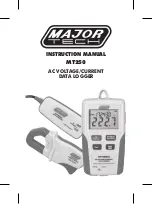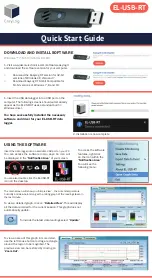
Section 8. Operation
391
Sensors with a high signal-to-noise ratio, such as a relative-humidity sensor with a
full-scale output of 0 to 1000 mV, can normally be measured as single-ended
without a significant reduction in accuracy or precision.
Sensors with a low signal-to-noise ratio, such as thermocouples, should normally
be measured differentially. However, if the measurement to be made does not
require high accuracy or precision, such as thermocouples measuring brush-fire
temperatures, which can exceed 2500 °C, a single-ended measurement may be
appropriate. If sensors require differential measurement, but adequate input
terminals are not available, an analog multiplexer should be acquired to expand
differential input capacity.
Because a single-ended measurement is referenced to CR6 ground, any difference
in ground potential between the sensor and the CR6 will result in an error in the
measurement. For example, if the measuring junction of a copper-constantan
thermocouple being used to measure soil temperature is not insulated, and the
potential of earth ground is 1 mV greater at the sensor than at the point where the
CR6 is grounded, the measured voltage will be 1 mV greater than the true
thermocouple output, or report a temperature that is approximately 25 °C too
high. A common problem with ground-potential difference occurs in applications
wherein external, signal-conditioning circuitry is powered by the same source as
the CR6, such as an ac mains power receptacle. Despite being tied to the same
ground, differences in current drain and lead resistance may result in a different
ground potential between the two instruments. So, as a precaution, a differential
measurement should be made on the analog output from an external signal
conditioner; differential measurements MUST be used when the low input is
known to be different from ground.
First Notch Frequency
Take Home
The smaller the fN1, the longer the signal integration time.
Integration time, a feature of analog measurements in older Campbell
Scientific dataloggers, was the time the analog signal was held in an
integration (averaging) circuit before the A-to-D conversion to average out
signal ripples caused by noise. All you may need to know about first
notch frequency (fN1) in the CR6 is that integration time is the reciprocal
of fN1 (Integ = 1/fN1). Two practical applications are that 1) when fN1 =
50 Hz, the integration time is 0.02 s or 20 ms; this will filter out 50 Hz noise
from 50 Hz that originate from 50 Hz ac power mains. When fN1 = 60 Hz,
noise from 60 Hz ac power mains is filtered.
All analog signals have a certain amount of noise that cause error in the
measurement. In selecting the first notch frequency,
fN1
, you can filter specific
noise frequencies from the analog signal. The smaller the first notch frequency
entered, the longer the measurement takes to complete.
Note
See the technical paper
Preventing and Attacking Measurement
Noise Problems
, which is available at
www.campbellsci.com
.
The digital output from the CR6 delta sigma
A-to-D
(p. 573)
converter is passed
through a digital filter with the sinc frequency response illustrated in the figure
Normalized Sinc Frequency Reponse
(p. 392).
The sinc filter completely notches
out (rejects) signals at several frequencies. The first (lowest) notch frequency is
Summary of Contents for CR6 Series
Page 2: ......
Page 4: ......
Page 6: ......
Page 32: ......
Page 36: ......
Page 38: ......
Page 76: ...Section 5 Overview 76 FIGURE 20 Half Bridge Wiring Example Wind Vane Potentiometer ...
Page 80: ...Section 5 Overview 80 FIGURE 23 Pulse Input Wiring Example Anemometer ...
Page 136: ......
Page 454: ...Section 8 Operation 454 FIGURE 104 Narrow Sweep High Noise ...
Page 459: ...Section 8 Operation 459 FIGURE 106 Vibrating Wire Sensor Calibration Report ...
Page 535: ...Section 8 Operation 535 8 11 2 Data Display FIGURE 121 CR1000KD Displaying Data ...
Page 537: ...Section 8 Operation 537 FIGURE 123 CR1000KD Real Time Custom ...
Page 538: ...Section 8 Operation 538 8 11 2 3 Final Storage Data FIGURE 124 CR1000KD Final Storage Data ...
Page 539: ...Section 8 Operation 539 8 11 3 Run Stop Program FIGURE 125 CR1000KD Run Stop Program ...
Page 541: ...Section 8 Operation 541 FIGURE 127 CR1000KD File Edit ...
Page 546: ......
Page 552: ......
Page 610: ...Section 11 Glossary 610 FIGURE 137 Relationships of Accuracy Precision and Resolution ...
Page 612: ......
Page 648: ......
Page 650: ......
Page 688: ......
Page 689: ......
















































